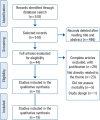Recruitment maneuvers in patients with acute respiratory distress syndrome: a systematic review and metanalysis
- PMID: 39699411
- PMCID: PMC11634339
- DOI: 10.31744/einstein_journal/2024RW0372
Recruitment maneuvers in patients with acute respiratory distress syndrome: a systematic review and metanalysis
Abstract
Objective: To systematically review the effects of recruitment maneuvers on patients with acute respiratory distress syndrome.
Methods: This systematic review and meta-analysis using the PICO methodology with keywords (respiratory distress syndrome, recruitment maneuvers, lung recruitment, acute respiratory distress syndrome, alveolar recruitment, and adult acute respiratory distress syndrome). Studies involving patients >18 years, regardless of sex, with acute respiratory distress syndrome, mechanically ventilated for at least 24 h, published in English, Portuguese, and Spanish, with no year restrictions, were included. Studies that combined recruitment maneuvers with other techniques and those conducted in animals were excluded. Boolean operators "AND" and "OR" were used.
Results: Fifteen studies were included. The recruitment maneuver proved to be effective in oxygenating patients (mean difference=45.05 mmHg (95% confidence interval (95%CI): 31.37-58.74)), but there was no statistically significant difference in the rate of mortality OR=0.89 (95%CI=0.74-1.08) and barotrauma RR=0.93 (95%CI=0.56-1.54).
Conclusion: Recruitment maneuvers should not be used routinely in the care of patients with acute respiratory distress syndrome, but it is a good rescue strategy when other methods fail to improve oxygenation.
Prospero database registration: (www.crd.york.ac.uk/prospero) under ID CRD42021227231.
Figures
References
-
- Brower RG, Matthay MA, Morris A, Schoenfeld D, Thompson BT, Wheeler A, Acute Respiratory Distress Syndrome Network Ventilation with lower tidal volumes as compared with traditional tidal volumes for acute lung injury and the acute respiratory distress syndrome. N Engl J Med. 2000;342(18):1301–1308. - PubMed
-
- Fan E, Checkley W, Stewart TE, Muscedere J, Lesur O, Granton JT, et al. Complications from recruitment maneuvers in patients with acute lung injury: secondary analysis from the lung open ventilation study. Respir Care. 2012;57(11):1842–1849. - PubMed
-
- O’Gara B, Fan E, Talmor DS. Controversies in the Management of Severe ARDS: Optimal Ventilator Management and Use of Rescue Therapies. Semin Respir Crit Care Med. 2015;36(6):823–834. - PubMed
Publication types
MeSH terms
LinkOut - more resources
Full Text Sources



